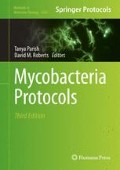Abstract
The intrinsic resistance of mycobacteria to most antimicrobial agents is mainly attributed to the synergy between their relatively impermeable cell wall and efflux systems. The mycobacterial cell wall is rich in lipids and polysaccharides making a compact envelope that limits drug uptake. Changes in cell wall composition or structure lead to variations in susceptibility to drugs. Bacterial efflux pumps are membrane proteins that are capable of actively transporting a broad range of substrates, including drugs, from the cytoplasm to the extracellular environment. Increased expression of efflux pump genes confers a low level resistance phenotype, and under these conditions, bacteria may have greater chances of acquiring chromosomal mutation(s) conferring higher levels of drug resistance. In order to develop effective antimycobacterial therapeutic strategies, the contributions to drug resistance made by the limited permeability of the cell wall and the increased expression of efflux pumps must be understood. In this chapter, we describe a method that allows: (1) the quantification of general efflux activity of mycobacterial strains (clinical isolates, mutants impaired in efflux or permeability) by the study of the transport (influx and efflux) of fluorescent compounds, such as ethidium bromide; and (2) the screening of compounds in search of inhibitors of efflux pumps, which could restore the effectiveness of antimicrobials that are subject to efflux.
Access this chapter
Tax calculation will be finalised at checkout
Purchases are for personal use only
References
Greulich KO (2004) Single molecule techniques for biomedicine and pharmacology. Curr Pharm Biotechnol 5:243–259
Jernaes MW, Steen HB (1994) Staining of Escherichia coli for flow cytometry: influx and efflux of ethidium bromide. Cytometry 17:302–309
Lomovskaya O, Bostian KA (2006) Practical applications and feasibility of efflux pump inhibitors in the clinic – a vision for applied use. Biochem Pharmacol 71:910–918
Viveiros M, Martins A, Paixão L et al (2008) Demonstration of intrinsic efflux activity of Escherichia coli K-12 AG100 by an automated ethidium bromide method. Int J Antimicrob Agents 31:458–462
Ramón-García S, Martín C, Aínsa JA et al (2006) Characterization of tetracycline resistance mediated by the efflux pump Tap from Mycobacterium fortuitum. J Antimicrob Chemother 57:252–259
Viveiros M, Martins M, Couto I et al (2008) New methods for the identification of efflux mediated MDR bacteria, genetic assessment of regulators and efflux pump constituents, characterization of efflux systems and screening for inhibitors of efflux pumps. Curr Drug Targets 9:760–778
Paixão L, Rodrigues L, Couto I et al (2009) Fluorometric determination of ethidium bromide efflux kinetics in Escherichia coli. J Biol Eng 3:18
Ramón-García S, Mick V, Dainese E et al (2012) Functional and genetic characterization of the tap efflux pump in Mycobacterium bovis BCG. Antimicrob Agents Chemother 56:2074–2083
De Rossi E, Aínsa JA, Riccardi G (2006) Role of mycobacterial efflux transporters in drug resistance: an unresolved question. FEMS Microbiol Rev 30:36–52
Adams KN, Takaki K, Connolly LE et al (2011) Drug tolerance in replicating mycobacteria mediated by a macrophage-induced efflux mechanism. Cell 145:39–53
Ramón-García S, Martín C, Thompson CJ et al (2009) Role of the Mycobacterium tuberculosis P55 efflux pump in intrinsic drug resistance, oxidative stress responses, and growth. Antimicrob Agents Chemother 53:3675–3682
Lee RE, Hurdle JG, Liu J et al (2014) Spectinamides: a new class of semisynthetic antituberculosis agents that overcome native drug efflux. Nat Med 20:152–158
Balganesh M, Dinesh N, Sharma S et al (2012) Efflux pumps of Mycobacterium tuberculosis play a significant role in antituberculosis activity of potential drug candidates. Antimicrob Agents Chemother 56:2643–2651
Balganesh M, Kuruppath S, Marcel N et al (2010) Rv1218c, an ABC transporter of Mycobacterium tuberculosis with implications in drug discovery. Antimicrob Agents Chemother 54:5167–5172
Viveiros M, Martins M, Rodrigues L et al (2012) Inhibitors of mycobacterial efflux pumps as potential boosters for anti-tubercular drugs. Expert Rev Anti Infect Ther 10:983–998
Rodrigues L, Ramos J, Couto I et al (2011) Ethidium bromide transport across Mycobacterium smegmatis cell-wall: correlation with antibiotic resistance. BMC Microbiol 11:35
Rodrigues L, Villellas C, Bailo R et al (2013) Role of the Mmr efflux pump in drug resistance in Mycobacterium tuberculosis. Antimicrob Agents Chemother 57:751–757
Machado L, Spengler G, Evaristo M et al (2011) Biological activity of twenty-three hydantoin derivatives on intrinsic efflux pump system of Salmonella enterica serovar Enteritidis NCTC 13349. In Vivo 25:769–772
Acknowledgement
This work was supported by grants FP7-260872 (European Union) “More Medicines for Tuberculosis,” BIO-2009-09405 from the Spanish Ministry for Science and Education, and project PTDC/BIA-MIC/121859/2010 from Fundação para a Ciência e a Tecnologia (FCT) Portugal. L. Rodrigues was supported by Fundación Agencia Aragonesa para la Investigación y el Desarrollo (ARAID).
Author information
Authors and Affiliations
Corresponding author
Editor information
Editors and Affiliations
Rights and permissions
Copyright information
© 2015 Springer Science+Business Media New York
About this protocol
Cite this protocol
Rodrigues, L., Viveiros, M., Aínsa, J.A. (2015). Measuring Efflux and Permeability in Mycobacteria. In: Parish, T., Roberts, D. (eds) Mycobacteria Protocols. Methods in Molecular Biology, vol 1285. Humana Press, New York, NY. https://doi.org/10.1007/978-1-4939-2450-9_13
Download citation
DOI: https://doi.org/10.1007/978-1-4939-2450-9_13
Published:
Publisher Name: Humana Press, New York, NY
Print ISBN: 978-1-4939-2449-3
Online ISBN: 978-1-4939-2450-9
eBook Packages: Springer Protocols

